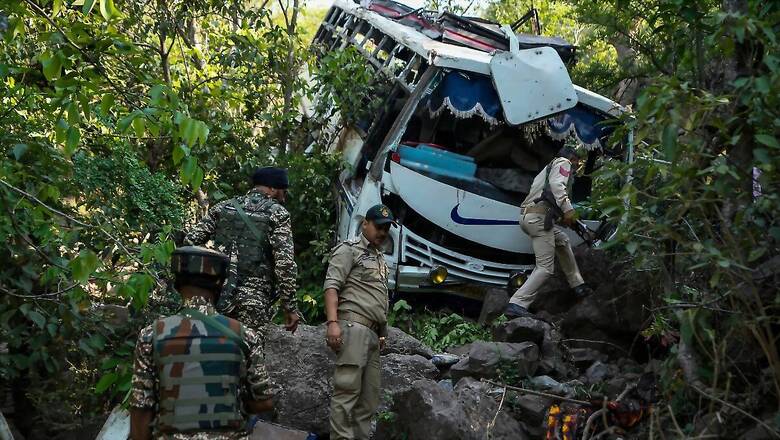
views
Four terror attacks in four days south of the Pir Panjal range in the Jammu division of the Union Territory (UT) of Jammu and Kashmir signal not just a shift in the centre of gravity and area of operation of terrorists, but also the strategic intent of their handlers and controllers sitting in Pakistan. That Jammu has seen a steady rise in incidents of terrorism since the constitutional reforms in J&K in 2019 is not exactly a new revelation.
With the security grid in the Kashmir valley being strengthened, the terrorists have shifted base to the Jammu division, where the terrain offers them some advantages, as also relatively easier ingress and egress routes to Pakistani-controlled areas of the UT. Given the mixed population in this region, it isn’t very difficult to find local support, more so because the political neglect of this region has made the ground fertile for subversive activity.
Alarm bells should have started ringing in corridors of power in both Srinagar and New Delhi many years ago when the first stirrings of political alienation in this belt started manifesting themselves. But a combination of hubris and self-deception, plus some strategic expediency, created a situation which allowed terrorists to restart their activities in this area.
For close to two decades, Jammu had been largely untouched by the scourge of terrorism. There were a few minor incidents but nothing that suggested a revival of terrorism in the area. But the ambushes of military vehicles, attacks on Army camps and clashes with security personnel since 2021 should have been seen as fitting a pattern that suggested that terrorists were trying to make a comeback in the region. There was, however, a ‘frog in a pot’ syndrome that seemed to plague the security assessment of events in Jammu.
Perhaps this was also the reason that the security presence in this area was thinned down and a division strength redeployed to beef up the presence along the Line of Actual Control (LAC) on the Northern axis facing China. Although this did create gaps in the security grid, it wasn’t seen as a problem because this was a ‘safe’ area.
However, now that the heat has been turned up, and things are starting to become uncomfortable, there is a better appreciation that what is happening in Jammu is not an isolated incident but part of a larger, more sinister plan of the terrorists and their handlers. This is also clear from the fact that in Kashmir, terrorists from proxy groups like ‘The Resistance Front’ or ‘People’s Anti-Fascist Front’ were not well-trained, disciplined, or battle-hardened killers. These were merely radicalised and Islamised young men who wanted to prove their machismo by gunning down unarmed, defenceless civilians.
The terrorists operating in Jammu are, however, much better trained. The kind of ambushes and attacks carried out suggest that along with experienced terrorist groups like Lashkar-e-Taiba and Jaish-e-Mohammed, there could also be Pakistani regulars or ex-servicemen (mostly from Pakistan-occupied Jammu and Kashmir) who have pressed into service. These terrorists appear to be operating in small 2-3 men groups (probably including a local) and living off the land. They make good use of the terrain to hit and run, and operations to track them are more complicated and manpower-intensive than in the Kashmir valley.
But with force levels increasing in the area and operations intensifying, it is only a matter of time before most of these terrorists are eliminated. However, beyond the immediate threat of a spike in terrorism in Jammu, the larger question remains: what has led to this situation? After all, the entire UT experienced very peaceful elections with an impressive voter turnout and engagement during the polls. Overall, the security situation in Kashmir is better than it has been in a long time. The 2019 constitutional reforms have changed the political and diplomatic equations in the erstwhile state and left Pakistan stunned, almost paralysed.
While all of this is undeniable, it is important for India to realise that it’s not a good idea to ever become complacent about an implacable enemy or an intractable problem, which is exactly what we might have been guilty of.
That the Pakistanis are down and out is a no-brainer. They are embroiled in domestic political turmoil, enmeshed not only in an extremely enervating Islamist insurgency in the Pashtun areas bordering Afghanistan, but also an unending Baloch resistance, and ensnared by a bankrupt economy. This is precisely why they desperately needed to signal to India that they remain in the fray, that they aren’t ready to throw in the towel, and are not going to let go of their beloved ‘Kashmir cause’, because to do that would be to accept Indian hegemony.
But the Pakistanis also know that they cannot afford a war-like situation with India. This means they need to carefully calibrate the violence to a point that stays below the threshold of tolerance in India. Otherwise, there could be another escalation from the Indian side – Balakot 2.0 or worse.
For the Gen Asim Munir-led military junta in Rawalpindi, rising tensions with India cut both ways: on one level, they make Pakistanis rally behind the Army, significantly reducing the disgust and disenchantment with the military, especially in Punjab; but on another level, rising tensions with India have a serious impact on an already struggling economy. Worse, at a time when security commitments are increasing on the western front with Afghanistan, an active eastern front with India imposes enormous pressure on the Pakistan Army, confronting them with a two-front situation.
One way to balance this is by asking the Chinese to increase pressure on India’s northern front. Perhaps this was discussed when Pakistan Prime Minister Shehbaz Sharif and his boss Gen Asim Munir visited Beijing around the time India’s election results were being declared.
What is clear, however, is that the spate of terror attacks is an open dare to Prime Minister Narendra Modi. The Pakistanis are testing him now that the elections are over and Modi is back, albeit with a reduced mandate. The primary reason why there was no major attack before or during the polls was because the Pakistanis wanted to avoid a redux of Pulwama and not give PM Modi another full toss to hit out of the ground. But now they want to see how much and how far they can push Modi 3.0 before he will respond, especially since he is now heading a coalition government. What the Pakistanis, who have a distorted military-run hybrid system, don’t understand is that the threshold is much lower at 240 seats in Lok Sabha than it was at 303 seats. PM Modi will have to reaffirm his credentials on national security, not only to push back against the jibes and barbs from the resurgent Opposition, but also to live up to the expectations of his core constituency.
Therefore, chances are that there will be retaliation. It won’t be a knee-jerk response. It might not even be a declared response like it was during the 2016 surgical strikes or the 2019 Balakot strike. But there will be a response. What will also force Modi’s hand is the election victory of a separatist in Kashmir and two in Punjab, which makes it necessary to disabuse India’s enemies (within and without) of the notion that they can destabilise India by weaponising democracy.
A message must be delivered not just to the separatists in India but also to their masters in Pakistan, that India will hit back and pay them in the same coin. Clearly then, tensions are likely to rise in the region. Going forward, the ceasefire along the Line of Control (LoC) could end and skirmishes could once again start along India’s Western frontier.
The author is Senior Fellow, Observer Research Foundation. Views expressed in the above piece are personal and solely that of the author. They do not necessarily reflect News18’s views.




















Comments
0 comment